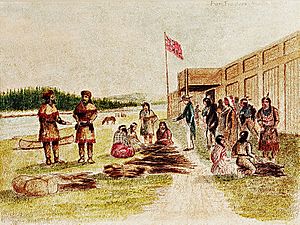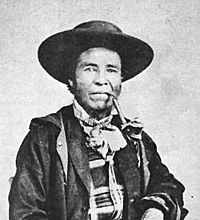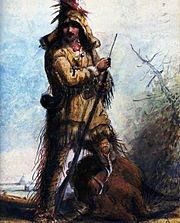Mountain man facts for kids
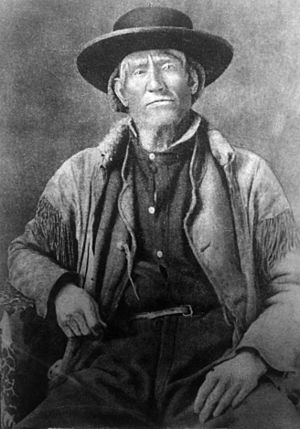
Jim Bridger, one of the most famous mountain men
|
|
| Occupation | |
|---|---|
| Frontiersman (1800–1890) | |
|
Activity sectors
|
Rocky Mountains, Sierra Nevada, Cascade Range, Great Plains, Great Lakes, Appalachian Mountains, Ozark Mountains, rivers |
| Description | |
| Competencies | Skinning, marksmanship, self-defense, hunting, fur trapping, trading, canoeing, horsemanship, tracking, exploring, mental and physical toughness, wilderness survival skills, medicine, frontier doctoring, diplomacy, English, French, Spanish, Russian, and Native American languages |
|
Related jobs
|
Longhunter, Coureur des bois, Surveyor, Woodsman, Fur trappers |
A mountain man was an explorer who lived in the wild American West. They made their living by hunting and trapping animals, especially for their fur. These brave adventurers were most common in the North American Rocky Mountains between 1810 and the 1880s. Their numbers were highest in the early 1840s.
Mountain men played a huge role in opening up the American West. They explored and improved many trails that later became wagon roads. These roads allowed Americans from the east to travel west in wagon trains and settle new territories. The mountain men and large fur companies first created these paths for mule trains carrying furs.
The mountain man era began because of the profitable North American fur trade. Reports from the 1806–1807 Lewis and Clark Expedition about the Rockies and the Oregon Country also sparked interest. For over 30 years, the fur trade helped mountain men earn a good living. However, by the late 1840s, this way of life largely ended. The fur industry declined due to less demand and too much trapping.
As the North American beaver fur trade collapsed in the 1830s–1840s, many mountain men found new jobs. Some became Army scouts or guides for wagon trains. Others, like William Sublette, opened trading posts along the Oregon Trail. These posts served the remaining fur trade and the settlers moving west.
Contents
The History of Mountain Men
Mountain men were most common in the North American Rocky Mountains from about 1810 to the 1880s. Their busiest time for beaver trapping was between 1820 and 1840. During these years, about 3,000 mountain men explored the mountains. John Colter was one of the very first mountain men, exploring alone in 1807–1808.
Many mountain men were "free trappers," meaning they worked for themselves. However, most were employed by big fur companies. Life as a company man was very organized. They lived in groups, hunted and trapped together in "brigades," and always reported to a leader called a "boosway." This leader was in charge of the brigade and handled trading.
In 1819, Donald Mackenzie of the North West Company held a special meeting called a rendezvous in the Boise River Valley. Later, William Henry Ashley of the Rocky Mountain Fur Company started using this rendezvous system regularly. His company would bring supplies to mountain locations in the spring. Trappers would trade their pelts for supplies. Then, the company would take the furs back to cities like St. Louis on the Missouri and Mississippi rivers in the fall.
Ashley later sold his business to Smith, Jackson, and Sublette. He still made money by selling them supplies. Other companies, like the American Fur Company owned by John Jacob Astor, also used this rendezvous system.
The annual rendezvous was often held at Horse Creek on the Green River in Wyoming. Another popular spot was Pierre's Hole. By the mid-1830s, 450–500 men attended each year, including almost all American trappers and traders in the Rockies, plus many Native Americans.
In the late 1830s, the Canadian-based Hudson's Bay Company (HBC) tried to weaken the American fur trade. Their annual Snake River Expedition became a trading trip. Starting in 1834, they visited the American rendezvous to buy furs cheaply. The HBC could offer manufactured goods at much lower prices than American companies. This, along with less demand for beaver fur and fewer beavers, effectively put American fur traders out of business by 1840. The last rendezvous was held in 1840. Around the same time, beaver hats became less popular in Europe, and beavers had been over-hunted.
By 1841, the American Fur Company and the Rocky Mountain Fur Company were struggling. By 1846, only about 50 American trappers remained in the Snake River country, down from 500–600 in 1826. After the HBC's success, the Snake River route became part of the Oregon Trail for settlers. Former trappers then found work as guides or hunters for these new groups.
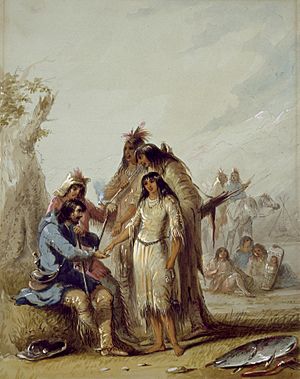
Another fur trading center grew in Taos, in what is now New Mexico. This trade attracted French Americans from Louisiana, French Canadian trappers, and Anglo-Americans. Some New Mexican residents also trapped beaver, as Mexican citizens had some legal advantages. Trappers in the Southwest explored areas not easily reached by large fur companies. This included parts of New Mexico, Nevada, California, and Utah. After the fur trade declined, many trappers became guides for settlers using the Mormon Trail.
British-Canadian companies, first the North West Company (NWC) and then the HBC, controlled the fur trade in the Pacific Northwest. They worked hard to stop American fur traders from competing west of the Rocky Mountains. After 1825, few American trappers worked west of the Rockies, and those who did found it unprofitable. This policy by the HBC forced American trappers to stay in the Rocky Mountains, which is how the term "mountain men" came about.
Mountain men were key in opening up the emigrant trails. These trails became wider wagon roads, allowing Americans to settle the far west. By the time new treaties in 1846 and 1848 added western coastal territories to the U.S., the fur trade was failing due to over-trapping. Luckily, America's western migration was growing fast. Settlers began moving along the Oregon Trail in 1841, and by 1847–49, a flood of emigrants headed west.
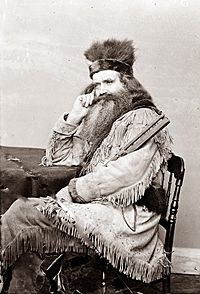
As the fur trade collapsed in the 1840s, mountain men changed jobs. The trails they had explored and improved became reliable wagon roads. This allowed them to work as guides and scouts. Mountain man Robert Newell told Jim Bridger: "We are done with this life in the mountains—done with wading in beaver dams, and freezing or starving alternately—done with Indian trading and Indian fighting. The fur trade is dead in the Rocky Mountains, and it is no place for us now if ever it was."
At the same time, the push west along the Oregon Trail grew rapidly. The Mormon migration used the road to the Great Salt Lake, discovered by Jim Bridger in 1847–48. The discovery of gold in California in 1848 led to the "Forty-Niners" flood in 1849.
Life in the Wilderness
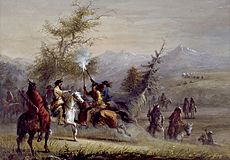
Life as a mountain man was very tough. Many did not survive more than a few years in the wilderness. They faced many dangers, especially when exploring new areas. Biting insects, wild animals, bad weather, diseases, and injuries were constant threats. Grizzly bears were one of their biggest enemies. Winters were harsh, with heavy snow and freezing temperatures.
To survive, these men needed sharp senses and knowledge of plants for medicine and first aid. In summer, they could catch fish, build shelters, and hunt for food and skins. Mountain men often wore clothes made of deer skin. These suits became stiff after being left outdoors, offering some protection against weapons. There were no doctors in the wilderness, so they had to set their own broken bones, treat their wounds, and heal themselves.
Fur Trappers and Company Men
A fur trapper was like a "free agent" today. They were independent and sold their furs to whoever offered the best price. This was different from a "company man," who usually owed money to one fur company for his gear. A company man traded only with that company and was often under their direct command. Some company men who paid off their debts could become free traders. They might still sell to the same company if the price was good or it was convenient.
Modern Reenactments
Historical reenactment of the mountain man lifestyle, sometimes called buckskinning, lets people experience parts of this historical period. Today's Rocky Mountain Rendezvous and other events are both historical and social gatherings. Some modern men choose to live a life similar to historical mountain men. They might live and travel in the mountains of the West or the swamps of the southern United States.

Famous Mountain Men
- Jim Beckwourth (1798–1866) was born into slavery but was freed by his father. He joined the Ashley expedition and later the Rocky Mountain Fur Company. He became a well-known mountain man and lived with the Crow for years, becoming a war chief. He was the only African American in the West to have his life story published (1856). He discovered Beckwourth Pass in the Sierra Nevada in 1850 and improved a Native American path, creating the Beckwourth Trail to Marysville, California.
- Jim Bridger (1804–1881) went west in 1822 at age 17. He was part of Ashley's Hundred exploring the Upper Missouri River area. He was among the first non-natives to see the geysers of the Yellowstone region. He was also one of the first Europeans, with Étienne Provost, to see the Great Salt Lake. Because it was salty, he first thought it was part of the Pacific Ocean. In 1830, Bridger bought shares in the Rocky Mountain Fur Company. He built Fort Bridger in southwestern Wyoming and was known for telling tall tales. Fort Bridger later played a role in the history of the Donner Party.
- Kit Carson (1809–1868) became famous later in life, but he started as a trapper. Carson explored from California north through the Rocky Mountains. He lived among and married into the Arapaho and Cheyenne tribes. John C. Frémont hired him as a guide, and Carson led him through much of California, Oregon, and the Great Basin area. Stories of his life as a mountain man made him a frontier hero.
- John Colter (1774–1812 or 1813), one of the first mountain men, was part of the Lewis and Clark Expedition. He was the first European to enter Yellowstone National Park and see Jackson Hole and the Teton Mountain Range. His descriptions of the hot springs there seemed so unbelievable that people jokingly called the area Colter's Hell. Colter's escape after being captured by Blackfeet became a legend known as "Colter's Run."
- Hugh Glass (1783–1833) was a frontiersman and fur trapper. He is famous for surviving a grizzly bear attack near the Missouri River. The films Man in the Wilderness (1971) and The Revenant (2015) are fictional stories based on Glass and the bear attack.
- John "Liver-Eating" Johnson (1824–1900) was a notable later-day mountain man. Johnson worked in Wyoming and Montana, trapping beaver, buffalo, and wolf hides. He was not tied to a company and sold his hides independently. Parts of his story were shown in the film Jeremiah Johnson.
- Jedediah Smith (1799–1831) was a hunter, trapper, and fur trader. His explorations were important in opening the American West for settlement. Smith is believed to be the first European to cross what would become Nevada. He was also the first to travel through Utah from north to south and west to east. He was the first American to enter California by land. He also climbed the High Sierra and explored from San Diego to the Columbia River. He was a successful businessman and a full partner in the Rocky Mountain Fur Company. Smith had noticeable scars on his face from a grizzly bear attack.
- William Sublette (1798–1845) was a fur trapper, pioneer, and mountain man. With his brothers after 1823, he became an agent and later an owner of the Rocky Mountain Fur Company. They explored the rich areas of the Oregon Country, helping to find the best routes that later became the Oregon Trail.
- Old Bill Williams (1787–1849) was a frontiersman and fur trapper. He is known for his expeditions to the American West and for being an interpreter for the U.S. government.
See also
 In Spanish: Mountain man para niños
In Spanish: Mountain man para niños
- Fort Laramie
- James "Grizzly" Adams
- Overmountain Men
- James Ohio Pattie
- Scottish Indian trade
- Coureur des bois
- Voyageurs
- Bandeirantes
- Promyshlenniki


